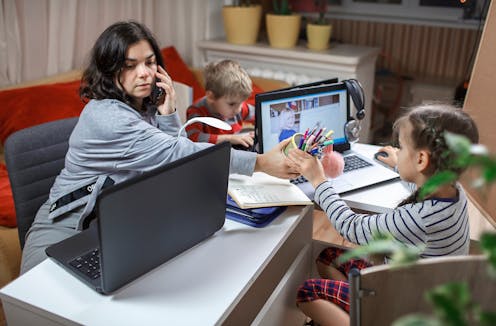Source: The Conversation (Au and NZ) – By Candice Harris, Professor of Management, Auckland University of Technology

shutterstock
All parents work.
The difference lies in the breakdown between their paid and unpaid workloads. That equation is influenced by many things, including education, qualifications, age, ethnicity, financial status, number and age of dependants, gendered and societal expectations, and personal choice.
But during COVID-19 lockdowns, many working parents have had to conduct their paid work – usually done in the workplace – at home.
Personally, professionally and geographically, this is new territory — for working parents, their loved ones and their employers.
It is also largely uncharted territory for researchers.
Previous academic studies of work-life integration have largely treated home and work as separate domains, with clearly demarcated tasks performed in distinct locations and at different times.
Additionally, past research into balancing those roles and working flexibly (including from home) has found parents mainly worked while children were at school or day care, or that they weren’t in full-time paid work.

shutterstock
The lockdown effect
Lockdowns have changed that, requiring many parents to work full-time while simultaneously schooling and caring for their children.
In this context, we suggest established, seemingly distinct concepts such as “work-life conflict” or “work-life balance” are limited in their ability to reflect and describe this new pandemic reality.
To that end, we have conceived a new concept that more accurately describes the working parent’s experience of juggling paid work (formal employment) and unpaid work (such as caregiving, household duties and volunteering) when both are being performed in the same environment during the same blocks of time.
We call it “zigzag working”.
Read more:
The double juggle: how working parents manage school holidays and their jobs
The working-from-home shuffle
Let’s imagine a typical example: Sarah teaches 26 nine- and 10-year-olds at a local primary school and is also mum to two kids aged 11 and 15, both studying from home during lockdown. Her husband is an essential worker, so he still goes out to work during the week.
One hour of her morning might look something like this:
9am: set up in the kitchen, designated as her “work zone”, she begins a Zoom session with her class to facilitate a 20-minute discussion
9.07am: motions to her teenage son not to eat the ingredients she is planning to use for dinner that night
9.20am: leaves the Zoom call, giving her students time to complete a task and for her to hang out a load of washing and reply to an email from a parent
9.35am: goes online again with her students for eight minutes to check their progress
9.41am: is approached by her 11-year-old daughter who needs help with her maths
9.50am: brings her class back together on Zoom to hear about their work, while also indicating to her son what he can eat from the fridge
Read more:
Working from home during COVID-19: What do employees really want?
Meeting and monitoring
Or another imaginary example: Ananya is a senior team manager working in banking. She’s a solo mum of twin boys aged 16, also studying at home and really missing soccer, which both play at a high level. They have a Labrador puppy.
1.15pm: listening live to her CEO update, she is texting her boys to encourage them to get out for a skate rather than spend their lunchtime gaming (they ignore her)
1.30pm: after the update, she grabs some of leftovers as lunch
1.37pm: takes a phone call from a team member
1.48pm: now that her boys have resumed online classes she sits down to reply to several emails
2.07pm: encourages one son to complete an overdue school project, as well as filling the dog’s water bowl
2.11pm: starts an urgent conversation via Teams with her manager
2.17pm: realises one of her twins is gaming when he’s meant to be working on his project
2.19pm: courier knocks on the door, no one else hears it, she interrupts another Teams meeting
New territory for employers
These scenarios illustrate the realities of zigzag working — the continuous and concurrent diving between paid and unpaid work as micro sessions, or managing paid and unpaid tasks simultaneously.
During lockdowns, many of the forms of support parents rely on – including relatives, paid household services, schools, day cares centres and after-school sports – are not available.
This is also new territory for employers, with many making up the rules as they go along and with large numbers of staff working at home full time.
We encourage employers to think about the roles working parents are juggling. Some tried and true forms of organisational support and being a “good employer” will no doubt apply here.
Read more:
How to deal with a year of accumulated burnout from working at home
Employers might also consider tweaks for lockdown working, including:
-
recognising that working parents may be frequently interrupted, prolonged periods of “focused time” do not exist, and there is no such thing as “complete silence”
-
not starting online meetings exactly on the hour, when school class sessions typically start
-
checking in advance with working parents when is convenient to take a call, or scheduling a time for one
-
breaking up long online meetings with micro breaks for all participants
-
recording organisational updates so parents can tune in at a time to suit the family schedule
-
enabling and encouraging staff to take reasonable breaks, as they would do in a normal work environment
-
encouraging and facilitating discussions of “chaos” to counteract notions of being the ideal worker or parent.
Read more:
Forget work-life balance – it’s all about integration in the age of COVID-19
Researching the new reality
Life was complex before COVID-19. Now it feels especially challenging.
We encourage employers to understand the reality of zigzag working and to play a positive part in it. As well, they should recognise zigzag working may also be experienced by working grandparents and contractors managing several jobs on top of family responsibilities.
For a parent, the impacts of zigzag working may be magnified if they have a partner also trying to do paid work in the home.
The permutations are many. So too are the research opportunities to study and understand this new zigzag reality.
![]()
Jarrod Haar receives funding from (1) Royal Society of New Zealand Te Apārangi; (2) The New Zealand Health Research Council, (3) Ngā Pae o te Māramatanga, and (4) New Zealand National Science Challenge: Science for Technological Innovation (Kia Kotahi Mai: Te Ao Pūtaiao me Te Ao Hangarau).
Candice Harris does not work for, consult, own shares in or receive funding from any company or organisation that would benefit from this article, and has disclosed no relevant affiliations beyond their academic appointment.
– ref. In a lockdown, where does work end and parenting begin? Welcome to the brave new world of ‘zigzag working’ – https://theconversation.com/in-a-lockdown-where-does-work-end-and-parenting-begin-welcome-to-the-brave-new-world-of-zigzag-working-169088







